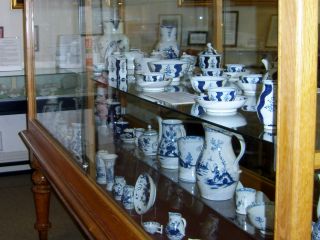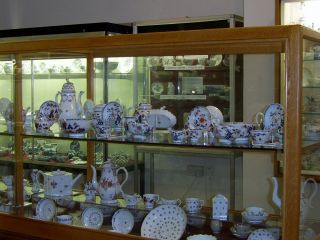|
 
LOWESTOFT PORCELAIN
At the time it was in operation, the Lowestoft Porcelain factory was located in a coastal town, in the north-eastern corner of Suffolk, at England’s most easterly point. Thus, it was in isolation from other centres of ceramic production in London, in the Midlands and in the North-west. The town had a population of about 1,800-2,000 people and was self-governing by means of its manorial court and parish vestry (it did not receive a charter until 1885 – the result of a great increase in population, following the coming of the railway and the expansion of the harbour forty years earlier). It had a complex occupational structure, with a wide range of trades, and it served as the market-town for the local area – though with much of its total economic effort devoted to maritime trade and herring fishing. Lowestoft occupied a cliff-top site, with the soft cliff-face itself terraced to make it usable and with the wide beach below accessed by a number of steep tracks known as scores. It had one main street (containing the principal houses, inns and shops), about 1,000 yards in length and with a slight sinuosity caused by following the line of the cliff – and there was a fifty-foot drop over that length from north to south. To the west of it lay an area of densely-built smaller houses and workshops, set out on a grid of cross-lanes. The whole built-up area covered about sixty acres and there were around 400 dwellings in all. Some contemporary opinions of the town were not flattering, while others were more laudatory. Much would have depended, of course, on the individual commentators and their criteria for judgement.
Background commentary
Various aspects of the porcelain enterprise’s origins have been commented on over the years, but it is worth pointing out that they were rooted in a national movement, whereby society developed a sense of growing “politeness” (at least, in those levels which could afford it!) and the wish to display this publicly. Lowestoft’s social development as a coastal resort occurred a generation later than what has been observed in other places, with the first bathing machines being placed on the beach in 1768, but it was only one feature of which note should be taken. Of equal importance was the building of an assembly room c. 1760 at The Queen’s Head inn, in Tyler’s Lane (now Compass Street), and the starting of a book club in town – cultural advances which were reinforced by the construction of a new turnpike road. This facility linked Lowestoft with Great Yarmouth, an important regional centre, and led to the provision of a mail-cart (which passed through the town twice daily with letters to and from London) and to a daily stagecoach service with the capital. It is, therefore, no coincidence that a porcelain-making venture should have begun at a time of such social innovation.
Nor should the rise of what has become known as “conspicuous consumption” be ignored as a contributory factor in the production of soft-paste porcelain. The growth in the manufacture and sale of luxury goods during the seventeenth and eighteenth centuries has been well recorded, with the role of women recognised as crucial – and Lowestoft had a variety of retail shops to satisfy the need to purchase consumer items. Furthermore, tea-drinking, as a polite activity and visible means of cultural expression, was well established in the town by the third decade of the eighteenth century, if the presence of the silver tea-spoons listed in certain of the wealthier citizens’ probate inventories is anything to go by. Imported Chinese hard-paste porcelain had begun to be brought into Western Europe in increasing quantities from the early seventeenth century onwards, and rising demand for it across a widening range of social levels eventually led to the establishment of European factories such as Meissen and Vienna about a hundred years later. By the middle of the eighteenth century, English factories were producing less technically challenging soft-paste porcelain to satisfy growing home demand.
Thus, in the light of national trends, the establishment of a soft-paste porcelain enterprise at Lowestoft can be seen as part of a wider cultural pattern – not something which occurred in a particular location simply because the physical circumstances there favoured it. Or, put another way, the historical process of cause and effect may be seen to have been at work. This is not to dismiss the combination of local factors out of hand. Far from it. The collaboration of Philip Walker, Obed Aldred, Robert Browne and Robert Williams was crucial in starting and sustaining the venture (especially the input of the first three men named). So was the coincidence and combination of what may be termed “geo-economic” influences.
Foremost among these was the possible presence of suitable, nearby, white clay in the adjoining parish of Gunton – to the north of Lowestoft – the exact location of which has been much debated, but never precisely established (nor has any evidence yet been found of clay being brought into the town from distant sources, either by land or sea). Flint was abundant on the area’s beaches to provide a necessary source of silica in the porcelain’s body, while the third major constituent, cattle bone (burnt and reduced to ash, before use), was in plentiful supply as a by-product of Lowestoft’s butchery trade. This not only supplied the town and its neighbourhood, but was also an important element in the provisioning of trading ships which anchored offshore. Thus, with three of the main constituents necessary to make soft-paste porcelain easily available locally, all that was needed was the motivation to produce it and the technical expertise. The former requirement was to be had from the first two men named in the paragraph above; the latter had to be acquired from the third one and from other, outside sources.
ACKNOWLEDGEMENT
All of this information was taken from Ivan Bunn and David Butcher’s article ‘Lowestoft Porcelain: its origins, factory-site and workforce.' (Transactions of the English Ceramic Circle, vol. 21 (2010).
Many thanks to Ivan and David |